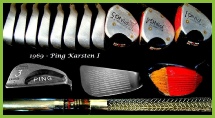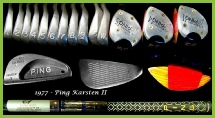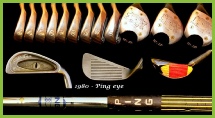
Taking Up Golf in 1953
That Solheim's next invention might involve the game of golf was highly improbable. A tennis player, he never even tried golf until moving to Ithaca, when in 1953 at the age of 42 he played a round with coworkers and became enamoured with the game. Putting was particularly troubling to Solheim, who soon concluded that a large part of his difficulties could be attributed to design flaws in his putter, which no matter how consistently he stroked it would twist just enough to send the ball off course. Knowing that a tennis racket employed perimeter weighting, in which the weight was distributed to the rim to allow the strings to provide greater power, Solheim decided to apply the same principle to the putter. By putting most of the weight at the heel and toe of the putter's blade he would be able to create a forgiving "sweet spot" in the center, allowing the player a much better chance to hit the ball straight. Solheim tested his idea by having a neighbor weld some metal to the back of the heel and toe of a putter, changes that helped the club head to complete a stroke. He then worked out the design of a new putter by gluing two popsicle sticks to the sides of a pair of sugar cubes with a shaft rising from the center. By the time he had constructed a prototype of his new putter, the 1A design, he had been transferred by GE to Palo Alto, California, where he worked with a team that produced the first banking computer system. Years later he recalled trying out the putter for the first time in 1959 in his kitchen in Redwood City, California: "I heard this noise, it startled me so much I dropped the putter on the floor. And then I knew that's what I would call my new putter: Ping."
As he continued to work for GE during the day, Solheim spent his weekends visiting golf course pro shops, giving away free putters to resident professionals to elicit feedback to help him improve the design. He even was known to lay out graph paper on the practice green to provide objective proof that his putter hit the ball straighter. One pro shop owner in 1959 urged him to manufacture the Ping putter and sell them through the club professionals. He also warned him not to quit his day job, advice that Solheim followed for several years. To fund the enterprise he took out a $1,100 bank loan, the only financing he would ever need. First in Redwood City and then in Phoenix after GE again transferred him in 1961, Solheim began to produce Ping putters in his garage at night, hand-grinding the heads in his garage and then heating them on the kitchen stove to fit them on shafts. His sons helped out, drilling holes in the putter head to accommodate the shaft and adding the grips. To market his revolutionary putter Solheim began to attend professional tournaments, lingering at the practice green to ask the players to try his putter. Many were reluctant because they considered the Ping to be ugly, a fact to which Solheim was indifferent, insistent that his club should be accepted because of what it could do, not its appearance. Golfers by nature were willing to try almost anything to improve their game, especially their putting, so enough pros gave the Ping a chance to begin to build word of mouth about the new putter, aided to some degree by Solheim engraving his name and address on the head. Winning tournaments, of course, translated into sales, as casual golfers, hoping the magic would rub off on them, invested in the same equipment as the victor of that weekend's tournament. In the early 1960’s the sale of Ping putters was spurred by Gloria Armstong's win in a his-her tournament and John Barnum's win of the 1962 Cajun Classic. A Sports Illustrated article on the "musical putter" also helped sell the Pings.
In 1962 Solheim received a patent on the heel-toe weighting design on his putter, but continued to work on improving the design while also beginning to develop irons. Because he lacked access to a wind tunnel, he had a son drive him 100 miles an hour in the desert in order to hold his prototype irons out the window to check the drag caused by a typical swing. In January 1966 an idea for a new putter came to him in a flash of inspiration. Unable to wait to get the concept down on paper he grabbed a record sleeve and sketched the design. His wife Louise thought the new putter should be called "answer," a name that Solheim liked but that possessed too many letters to fit on the club. She then suggested that the "w" be left out. The legendary "Anser" putter, used by countless tournament winners, was born, and Karsten Solheim was on the verge of finally quitting his day job.
Marketing of the Anser was still limited to word of mouth, but those voices would become greatly amplified by the rise of professional golf on television, fueled by the popularity of Arnold Palmer and the rising star of Jack Nicklaus. When Julius Boros won the PGA Tour's Phoenix Open in 1967 using a Ping Anser putter, sales took off. Solheim, not intending to quit his engineering job, continued to meet the demand for his putters through his garage operation, much to the annoyance of his neighbors, but when GE decided to once again transfer him, this time to Oklahoma City, he decided to try the golf business full time. He was 56 when in July 1967 he incorporated Karsten Manufacturing and then bought a 2,200-square-foot building in Phoenix. Years later he told an interviewer, "When I moved into that little room I felt like I was a king." He soon hired his first employee and a year later had 30 people on payroll. Even as a businessman Solheim revealed his innovative spirit. His company had no job descriptions; he simply hired talented people and allowed them to find their most valuable function in the organization. Within two years annual sales grew from $50,000 to $500,000, despite a problem with the United States Golfing Association, which outlawed all but one of the Ping putter designs because of a bend at the base of the grip that helped the head swing square to the ball. A settlement was eventually reached, resulting in some changes to the clubs. This difficulty with the establishment foreshadowed a more contentious battle years later.
Introducing Irons in 1969
Solheim's work on irons came to fruition in the late 1960’s. He applied the heel-toe, perimeter weighting principle to fashion a sweet spot on the irons and also employed investment casting, which was far more precise than the popular forging method. Other equipment makers produced shinier clubs, making Karsten irons look almost homemade, and once again Solheim insisted that his clubs be judged by their results. He refused even to add chrome plating in order to please customers. Performance eventually converted the reluctant, and that performance was enhanced by other Solheim innovations. He heat-treated the club heads to resist corrosion and add strength, but it also allowed them to be adjusted for loft and lie, meaning the clubs could be custom fitted to take into account the customer's stance and swing. In the early 1960’s Solheim had calibrated loft and lie angles for pro golfers, work that now led to the creation of the Ping Colour Code Fitting System. Each set of clubs was then numbered and the specifications kept on file, so that customers in need of a replacement would be able to obtain an exact replacement from the factory. The practice of custom fitting also meant that any Ping clubs found on the shelves were either used or fakes. Combating counterfeiters would become a major area of concern for Karsten over the ensuing years.
Between 1969 and 1976 the company came out with its Karsten I, II, III, and IV irons, followed by the popular Eye series starting in 1979. The company also produced woods but never captured much of the market. Nevertheless, Karsten dominated in putters and irons, making it the top golf equipment manufacturer and allowing Solheim to branch out into other golf products and other business activities, such as Solheim Engineering and Dolphin Inc., as well as the 1984 purchase of Moon Valley Country Club. It was Solheim's success as a golf club designer, in fact, that led to a major distraction in the late 1980’s, one that contributed to Karsten's loss of focus in the 1990’s.
In 1984 the USGA decided to permit U-shaped grooves in the face of an iron, as opposed to traditional V-shaped grooves. Solheim was quick to take advantage of this rule change with his Ping Eye 2 model, which quickly proved popular, ultimately becoming Karsten's best-selling club in history. Because the grooves were hard on soft-covered balls, Solheim rounded off the edges, which the USGA ruled was a violation and banned from professional play. In essence, the clubs provided extra spin, which made it easier for golfers to execute shots from difficult lies. Solheim insisted that his clubs were consistent with the USGA regulation and eventually took the organization, and later the PGA Tour, to court. Both suits were settled out of court, the USGA in 1990 and the PGA Tour in 1993. Kartsen's older irons were deemed legal but future clubs would have to comply with USGA regulations.
As Karsten emerged from its legal squabble in the 1990s it found itself operating in a new business environment. Other equipment manufacturers had followed Solheim's lead and greatly improved on their technology, but unlike Solheim they were more willing to please their customers and not insist that pure functionality rule the day. Moreover, they effectively advertised their wares, instead of relying on reputation, no matter how strong that reputation might be. Karsten began to lose significant market share, with its top-selling irons falling second to rival Cobra in 1995. It was clear that change was needed and as a result Solheim's son John Solheim took over as president and soon presided over the first layoffs in nearly three decades and instituted a number of changes over the next few years. The company updated its marketing approach, replacing its staid print ads with bolder designs and adding broadcast advertisements; it introduced oversized metal woods that had become popular with players; and instead of merely offering bonus money based on performance to professionals who played with Ping equipment it began to offer a salary to select players.
In the late 1990’s Karsten was well on its way to recovery, while at the same time its founder, suffering from Parkinson's disease, began to steadily decline. During his last years he was bound to a wheelchair. He died from complications of the disease on February 16, 2000, at the age of 88. Although a maverick who was never part of the golfing establishment, Karsten Solheim was acknowledged by all as one of the most important influences on golf club development in the modern era. His sons now led the company he created and a third generation was preparing to carry on his commitment to innovation and craftsmanship.



